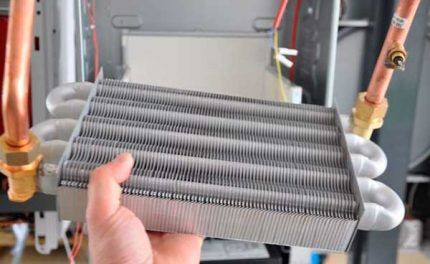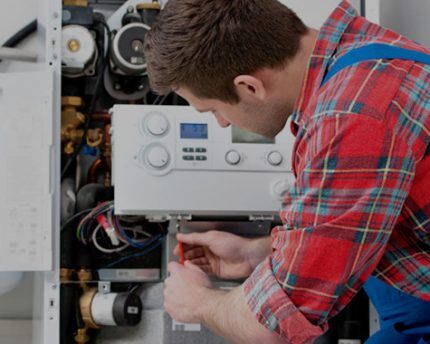Why does a geyser heat up the water and the body so much: how to prevent overheating
People have been using gas water heaters for more than 100 years. They appeared in our country in 1956.The most popular are instantaneous water heaters, popularly known as geysers.
Agree that this device is much more reliable than a boiler. However, there are often cases when a gas water heater heats up the water too much. The temperature of the heated water should not be too high, as this causes a lot of inconvenience and negatively affects the water heater.
We will consider in detail the possible causes of this problem and the most effective ways to solve it. Don't rush to call a specialist. Try to repair the gas water heater yourself, and we will help you with this.
The content of the article:
Instantaneous water heater device
A geyser is capable of instantly changing the temperature of water, which is heated using a direct-flow circuit. There is no tank in this equipment. The device contains a plate heat exchanger, most often made of copper.
A water tube passes through it. Gas burners are located below. The heat exchanger plates are heated by the combustion gas and, in turn, heat the water tube.
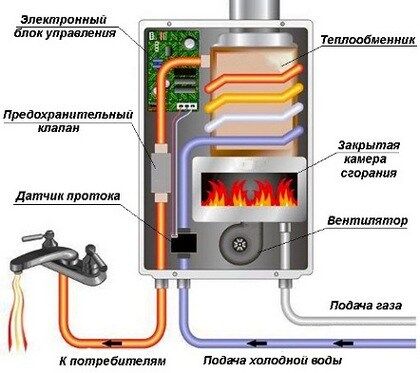
At the top of the device there is an exhaust gas collector. In it, the combustion products of blue fuel are accumulated and redirected into the chimney. On the body of gas boilers there are regulators with which the water pressure and gas supply are adjusted. Thanks to them, the water heating temperature is set individually.
Recommended temperatures are not higher than 42-50°C. A higher temperature leads to active deposition of salts on the heater parts. As a result, the body of the geyser becomes overheated, and very hot water flows from the tap.
Reasons for water overheating by a column
There are several reasons why a geyser overheats water:
- the heat exchanger is clogged;
- minor water pressure;
- untimely filter replacement;
- regulators are installed incorrectly;
- low mixer capacity.
Most often, the cause of strong heating of water or the body of the boiler itself is a clogged heat exchanger. Overheating can also be a consequence of turning on the equipment when water pipes and heating pipes are blocked.
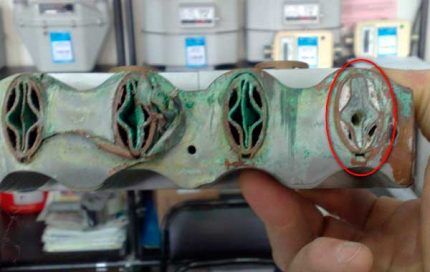
To identify the true cause, it is first recommended to check the operation of the pump and the circulation of water through the heating system.
Low water pressure
If the water in the tap is either extremely hot or cold, the cause of such “swings” is poor pressure in the main line or a mismatch between the water pressure and the power of the dispenser.The throughput of brands such as Bosch, Ariston, Baltgaz, Nevalux, Electrolux, etc. is 11 l/min. With little pressure, overheating occurs.
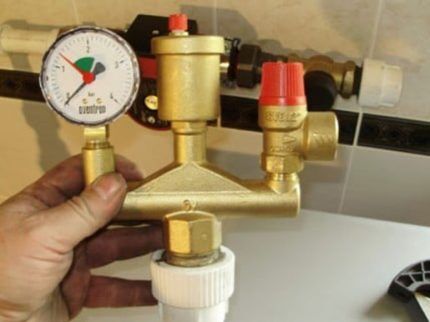
To solve the problem with pressure, contact the city water utility.
Late filter replacement
The quality of tap water leaves much to be desired. To minimize its destructive effect on equipment, a mesh type filter is installed. It traps small debris, purifies water from impurities and softens it.
If the filter has not been changed for a long time, then water with magnesium and potassium salts gets into the column. As a result, scale deposits on the parts. This calcium deposit often causes equipment failure.
Regulators are installed incorrectly
Do you change the position of the regulator in a timely manner depending on seasonality? Often the cause of strong heating of water geyser is the change of seasons of the year. In spring, the water in the communications becomes warmer, and the gas supply regulator is set to the maximum value.
At the same time, the water supply regulator remains at the minimum level (as in winter). As a result, the water becomes too hot in summer.
Low mixer capacity
Another common problem is when the water temperature in the kitchen is comfortable, but boiling water is pouring from the shower.
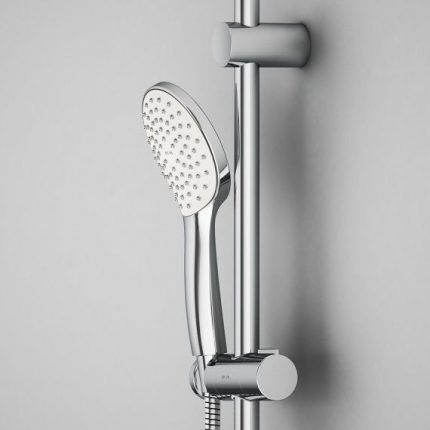
In this case, the problem is caused by the low flow capacity of the shower faucet.The only solution is to purchase a mixer with maximum throughput.
How to troubleshoot?
If the body of the geyser heats up due to contamination in the communications, then they should be cleaned. To do this, you need to check the inlet and outlet water supply hoses, the axle box tap and the mixer cartridges. The hoses are cleaned under running water.
If the regulator is installed incorrectly, the water heater must be switched to summer mode. The initial outlet water temperature is affected by the inlet fluid temperature. For example, the device heats water to +35°C.
In summer, the inlet water temperature is +15°C. Consequently, at the outlet the liquid will warm up to +50°C. In winter, when the inlet water temperature is lower, this figure also decreases.
Cleaning the heat exchanger from scale
If your geyser body heats up, you should check the condition of the heat exchanger. Since water is heated by gas, over time, equipment parts become covered with soot and scale.
Due to hard water, the channels of the heat exchanger tubes become clogged with salts, which interferes with the circulation of the liquid. To restore the operation of the gas boiler, it is necessary to clean the heat exchanger.
First of all, you should turn off the gas supply and disconnect the equipment from the power supply. After the device has cooled down, you need to disassemble the boiler according to the operating instructions. After removing the filter, it is cleaned mechanically. If the condition of the part is extremely neglected, it is recommended to replace it.
Hydrochloric acid cleaning
The first reagent for self-cleaning the heat exchanger is hydrochloric acid.

Sequence of actions when cleaning with hydrochloric acid:
- turn off the water and drain all the hot liquid by opening the mixer;
- remove the casing;
- unscrew the screws holding it;
- disconnect the thread of the heat exchanger (water may flow out, so it is recommended to substitute a container);
- prepare a solution of hydrochloric acid (no more than 3-5%);
- using a pipe or hose with a ½-inch thread, connect the radiator inlet and outlet;
- Place a funnel on the pipe and pour the solution into it.
All work must be done with gloves. Foam may form as a result of the reaction between hydrochloric acid and scale. After cleaning is completed, the heat exchanger should be flushed to remove acid residues.
Cleaning via tank with pump
To work, prepare a 7-10% acid solution. You will also need a tank and a centrifugal pump.
Sequencing:
- shut off the gas and water supply;
- drain the remaining water by opening the mixer;
- unscrew the bolts to disassemble the casing and gain access to the radiator;
- pour the acid solution into the tank;
- connect the cleaning system to the heat exchanger;
- start the pump.
The liquid should be driven through the heat exchanger for an hour until all contaminants are removed. If necessary, after cleaning, the poured reagents should be neutralized with a special solution or rinsed well with water.
Use of citric acid
Take a deep container in which the heat exchanger can easily fit. For 700 ml of water you will need 80 g of citric acid.
Fill the container with water approximately 30%, immerse the radiator in it and pour in the acid solution. Warm contents for 30 minutes.

Before assembling the device, rinse the parts under running water to remove any remaining scale. Preventative cleaning is recommended once a year.
After cleaning the heat exchanger, all parts of the gas water heater are connected in the reverse order. Before use, you should check the functionality of the entire device. With timely cleaning, the geyser will last as long as possible, and the heat exchanger will not consume more gas.
Care and maintenance of the geyser
Regular maintenance is important for reliable and long-lasting operation of the device. Every year of operation, the boiler should be inspected, preventative cleaning of parts, control and safety elements should be checked, as well as the tightness of the gas and water distribution.
In order for a gas boiler to work correctly, it is necessary to control the pressure coolant at the exit from the equipment. If the pressure is below 0.8 bar, the heating system must be topped up.
Annual prevention includes:
- checking the traction and performance of gas equipment;
- inspection of the condition of the heat exchanger;
- checking traction and ignition;
- inspection of the structure and determination of the need to clean the body.
Most often, once a year it is enough to clean the heat exchanger, housing and burner.
When the seasons change, it is necessary to prepare the equipment for further use.Most often, the check is carried out before the onset of cold weather, when the load on the device increases.
Conclusions and useful video on the topic
Troubleshooting a gas boiler:
Cleaning the heat exchanger yourself:
A geyser is equipment that ensures uninterrupted preparation of hot water and serves individual heating. In order for the device to work correctly, it should be regularly inspected. Without this, the equipment will quickly break down and require major repairs or the purchase of a new boiler.
Share in the comments your history of using a gas boiler, as well as what malfunctions you encountered and how you got out of the situation. If you know other ways to clean the heat exchanger yourself, please tell us about it by filling out the form below.
